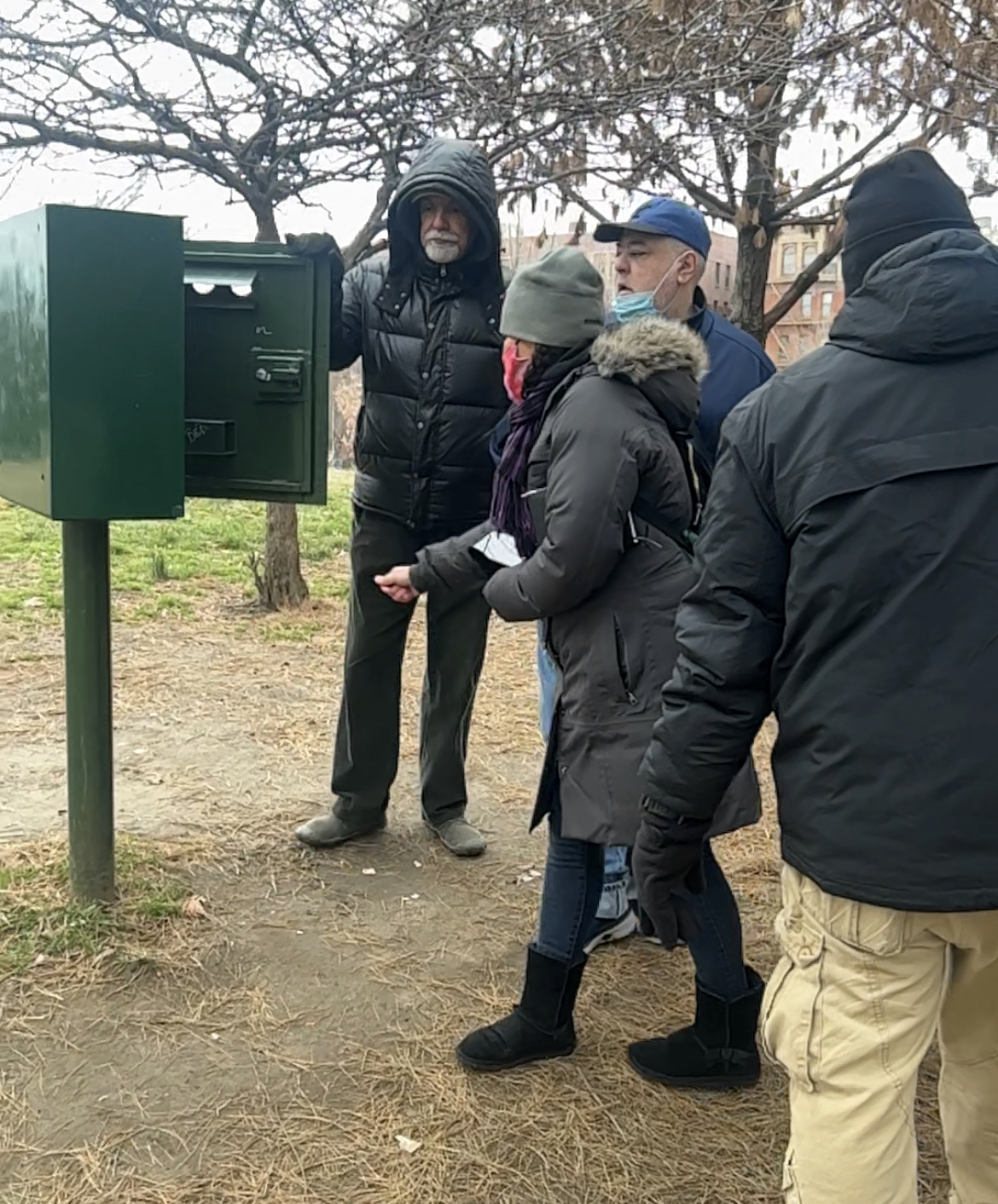A group of six concerned citizens walked through St. Mary’s Park on a Tuesday afternoon in late January, to see what impact syringe disposal boxes are having on one of the South Bronx’s few sizable public green spaces.
One box was tilted and could be easily opened. Another sat askew on its hinges, open to two needles and caps resting in the box. The third had only its supporting pole remaining; the box it had rested on was gone.
The group’s organizer, Carmen Santiago, has been on a crusade to remove needle boxes from St. Mary’s, arguing that they are not only a public health menace for people longing for a safe outdoor space, they are also an invitation for drug users. She regularly leads walking tours of the park to call attention to what she says is a significant public health concern the city isn’t doing enough about.
The broken boxes, which were installed in the park in 2019, are now surrounded by discarded and toxic drug paraphernalia that cover the rocks and grass, having themselves become trash.
“Can you believe they want to fix these boxes?” Santiago said to the group she had brought together. “I think they should just get rid of them. The parks department put them up and the parks department should take them down.”
A spokesperson for the parks department, informed of Santiago’s efforts, responded by email to an inquiry from The Herald, saying, “We are looking into the concerns raised.”
Installation of the boxes followed roughly five years of discussion between the community and city, state and federal officials. The strategy of putting the boxes up in public places is known as harm reduction, and is intended to help substance users curtail their addiction while receiving mental health counseling.
Spurred by a spate of deaths nationally from fentanyl-laced drugs, harm reduction has become a popular approach to taming illegal drug use, while de-stigmatizing addicts and responding with less punitive societal responses.
But on St. Mary’s 33 acres, the ideals of social justice and humane treatment for drug users clash with the park as an innocent escape for families and young people.
The parks department’s website states that “As the largest park in the South Bronx, St. Mary’s Park gets plenty of love from those living in the area,” as “an oasis of fun and relaxation in a busy area. The lawns are particularly popular with picnickers, and families bring baskets full of food to grill on warm summer days.”
Santiago and others in the neighborhood long for a day in the park to be that simple again.
Nationwide, at least 20 states have placed needle boxes in their public parks. According to public health experts, however, public needle boxes as a stand-alone component have yet to be proven effective. A strategy that has proven to be effective is needle exchange programs. In Manhattan, two safe rooms recently opened, where users are provided clean needles, and administered naloxone to reverse overdoses.
As the concerned citizens made their rounds, one young woman, Helen Batiz, walked by with her groceries. Looking around, she noted that several years ago, the south end – where she lives – was also unsafe to take her children.
But after many of her neighbors complained about drug transactions nearby, that section of the park was redesigned, with features such as a chess table and a playground added. There has been no evidence of drugs since then, Batiz said, adding that she now takes her young kids to the park without hesitation because she feels safer.
Santiago says that distinction is no accident. Because the streets just south of St. Mary’s are made up mostly of private residences, the city has paid more attention to that section.
But because the north side of St. Mary’s is bordered by NYCHA’s Moore Houses and two schools rather than homeowners, she contends, the city hasn’t taken the steps it needs to to make it safe.
Sonia Taylor, a Mott Haven resident who participated in the walk, reminisced about her son’s days running and sliding over the rocks in the park. With a wistful smile, she lamented that she doesn’t dare take her 12-year-old granddaughter Skyla to follow in his footsteps.
At the 40th Precinct Community Council’s Feburary meeting at the YMCA in Melrose a week later, Santiago urged police officers to ramp up patrols at St. Mary’s, while passing around photos of the broken needle boxes, discarded syringes and orange caps littered on the grass and between rocks.
“There’s grown men, half naked sometimes, lined up 20 or 30 deep, waiting for the ‘doctor’ to shoot them up in the neck. You see these men, searching for a vein,” she said.
Capt. Rebecca Bukofzer-Tavarez, executive officer for the 40th precinct, responded that the NYPD is doing its best.
“We can’t arrest addicts for being addicts, nor homeless for being homeless,” Bukofzer-Tavarez said, encouraging residents to register their complaints with the parks department. “If there are enough squeaky wheels, they will listen.”
Additional reporting by Sunny Nagpaul.

